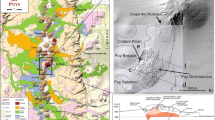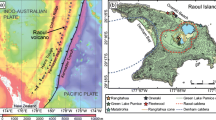Abstract
Microtextural characteristics of fresh ejecta from Stromboli volcano were examined from three periods of differing eruption style and intensity in 2002. Activity shifted from relatively weak and infrequent ash-charged explosions during January through May into two broad cycles of waxing activity in June through late September, and late September through December, followed by the onset on 28 December of the 2002/2003 effusive eruption. Analyzed sets of lapilli from May, September/October, and 28 December show contrasts in the physical properties of magma resident in the shallow conduit during this range of activity. Three distinct textures are observed among the analyzed pyroclasts: low density (LD) with an abundance of subspherical bubbles, the presence of large, irregularly shaped bubbles, and a light-to-transparent glass matrix; transitional texture (TT) with an intermediate number of subspherical bubbles, a high frequency of large, irregularly-shaped bubbles, and a honey colored glass matrix; and high density (HD) with sparse relatively small bubbles, conspicuous large irregular bubbles, and a dark glass matrix. Observational and quantitative data (density, vesicle size) indicate that these textures are linked through variable residence time in Stromboli’s shallow conduit, with an ongoing evolution from LD to HD magma. Calculations suggest that residual LD magma will evolve to HD texture in a period of hours to days. Contrasting amounts of the LD, TT, and HD magmas are present in each sample, with the most TT in May, the most LD in September/October, and the most HD in December. This implies that the shallow magma had a different rheology at each collection period. The viscosity of LD and HD magmas are calculated to be in the range of 2,000 to 2,600 and 3,000 to 5,000 Pa s, respectively, which, with their changing proportions, must have implications for rates of bubble slug ascent and processes of fragmentation. This study suggests that an increasing maturity of magma in Stromboli’s shallow conduit (with resultant increase in viscosity) feeds back to reduce the intensity of explosions, whereas a steady flux of LD magma favors more powerful explosions.








Similar content being viewed by others
References
Adams NK, Houghton BF, Fagents SA, Hildreth W (2006) The transition from explosive to effusive eruptive regime: the example of the 1912 Novarupta eruption, Alaska. Geol Soc Am Bull 118:620–634. DOI 10.1130/B25768.1
Aiuppa A, Federico C (2004) Anomalous magmatic degassing prior to the 5th April 2003 paroxysm on Stromboli. Geophys Res Lett 31:L14607. 10.1029/2004GL020458
Alean J, Carniel R, Fulle M (2005) Stromboli online — Volcanoes of the World on Swisseduc.ch, http://stromboli.net. Cited 5 May 2005
Allard P, Carbonnelle J, Metrich N, Loyer H, Zettwog P (1994) Sulphur output and magma degassing budget of Stromboli volcano. Nature 368:326–330
Bagdassarov N, Pinkerton H (2004) Transient phenomena in vesicular lava flows based on laboratory experiments with analogue materials. J Volcanol Geotherm Res 132:115–136
Barberi F, Rosi M, Sodi A (1993) Volcanic hazard assessment at Stromboli based on review of historical data. Acta Vulcanol 3:173–187
Bertagnini A, Metrich N, Landi P, Rosi M (2003) Stromboli volcano (Aeolian Archipelago, Italy): an open window on the deep-feeding system of a steady state basaltic volcano. J Geophys Res 108:2336. DOI 10.1029/2002JB002146
Blackburn EA, Wilson L, Sparks RSJ (1976) Mechanisms and dynamics of strombolian activity. J Geol Soc London 132:429–440
Blower JD, Keating JP, Mader HM, Phillips JC (2001) Inferring volcanic degassing processes from vesicle size distributions. Geophys Res Lett 28:347–350. DOI 10.1029/2000GL012188
Blower JD, Keating JP, Mader HM, Phillips JC (2002) The evolution of bubble size distributions in volcanic eruptions. J Volcanol Geotherm Res 120:1–23
Bonaccorso A, Calvari S, Garfi G, Lodato L, Patane D (2003) Dynamics of the December 2002 flank failure and tsunami at Stromboli volcano inferred by volcanological and geophysical observations. Geophys Res Lett 30:1941–1944. DOI 10.1029/2003GL018896
Bottinga Y, Weill DF (1970) Densities of liquid silicate systems calculated from partial molar volumes of oxide components. Am J Sci 269:169–182
Calvari S, Spampinato S, Lodato L, Harris AJL, Patrick MR, Dehn J, Burton MR, Andronico D (2005) Chronology and complex volcanic processes during the 2002–2003 flank eruption at Stromboli volcano (Italy) reconstructed from direct observations and surveys with a handheld thermal camera. J Geophys Res 110:B02201. DOI 10.1029/2004JB003129
Calvari S, Spampinato L, Lodato L (2006) The 5 April 2003 vulcanian paroxysmal explosion at Stromboli (Italy) from field observations and thermal data. J Volcanol Geotherm Res 149:160–175
Cashman KV, Mangan MT (1994) Physical aspects of magmatic degassing II. Constraints on vesiculation processes from textural studies of eruptive products. In: Carroll MR, Holloway JR (eds) Volatiles in Magmas. Rev Mineral 30:447–478
Cashman K, Blundy J (2000) Degassing and crystallization of ascending andesite and dacite. Phil Trans R Soc London 358:1487–1513
Chouet B, Saccorotti G, Dawson P, Martini M, Scarpa R, Deluca G, Milana G, Cattaneo M (1999) Broadband measurements of the sources of explosions at Stromboli Volcano, Italy. Geophys Res Lett 26:1937–1940
Chouet B, Dawson P, Ohminato T, Martini M, Saccarotti G, Giudicepietro F, de Luca G, Milana G, Scarpa R (2003) Source mechanisms of explosions at Stromboli Volcano, Italy, determined from moment-tensor inversions of very-long-period data. J Geophys Res 108:1–25. DOI 10.1029/2002JB001919
Harris AJL, Stevenson DS (1997) Thermal observations of degassing open conduits and fumaroles at Stromboli and Vulcano using remotely sensed data. J Volcanol Geotherm Res 76:175–198
Houghton BF, Wilson CJN (1989) A vesicularity index for pyroclastic deposits. Bull Volcanol 51:451–462
Houghton BF, Wilson CJN, Del Carlo PO, Coltelli M, Sable JE, Carey R (2004) The influence of conduit processes on changes in style of basaltic plinian eruptions: Tarawera 1886 and Etna 122 BC. J Volcanol Geotherm Res 137:1–14
James MR, Lane SJ, Chouet B, Gilbert JS (2004) Pressure changes associated with the ascent and bursting of gas slugs in liquid-filled vertical and inclined conduits. J Volcanol Geotherm Res 129:61–82
Jaupart C, Vergniolle S (1988) Laboratory models of Hawaiian and Strombolian eruptions. Nature 331:58–60
Jaupart C, Vergniolle S (1989) The generation and collapse of a foam layer at the roof of a basaltic magma chamber. J Fluid Mech 203:347–380
Klug C, Cashman KV (1994) Vesiculation of May 18, 1980, Mount St-Helens Magma. Geology 22:468–472
Klug C, Cashman KV, Bacon CR (2002) Structure and physical characteristics of pumice from the climactic eruption of Mount Mazama (Crater Lake), Oregon. Bull Volcanol 64:486–501
Lautze NC, Houghton BF (2005) Physical mingling of magma and complex eruption dynamics in the shallow conduit at Stromboli volcano, Italy. Geology 33:425–428
Llewellin EW, Manga M (2005) Bubble suspension rheology and implications for conduit flow. J Volcanol Geotherm Res 143:205–217
Mangan MT, Cashman KV, Newman S (1993) Vesiculation of basaltic magma during eruption. Geology 21:157–160
Mangan MT, Cashman KV (1996) The structure of basaltic scoria and reticulite and inferences for vesiculation, foam formation, and fragmentation in lava fountains. J Volcanol Geotherm Res 73:1–18
Marchetti E, Ripepe M (2005) Stability of the seismic source during effusive and explosive activity at Stromboli Volcano. Geophys Res Lett 32: L03307. DOI 10.1029/2004GL021406
Mastin L, Christiansen B, Thornber C, Lowenstern JB, Beeson MH (2004) What makes hydromagmatic eruptions violent? Some insights from Keanakako’i Ash, Kilauea Volcano, Hawai’i. J Volcanol Geotherm Res 137:15–31
Métrich N, Bertagnini A, Landi P, Rosi M (2001) Crystallization driven by decompression and water loss at Stromboli Volcano (Aeolian Islands, Italy). J Petrol 42:1471–1490
Parfitt EA, Wilson L (1995) Explosive volcanic eruptions — IX. The transition between Hawaiian-style lava fountaining and Strombolian explosive activity. Geophys J Internat 121:226–232
Parfitt EA (2004) A discussion of the mechanisms of explosive basaltic eruptions. J Volcanol Geotherm Res 134:77–107
Patrick M, Harris AJL, Ripepe M, Dehn J, Rothery DA, Calvari S (2006) Strombolian explosive styles and source conditions: insights from thermal (FLIR) video. Bull Volcanol (in press)
Polacci M, Pioli L, Rosi M (2003) The Plinian phase of the Campanian Ignimbrite eruption (Phlegrean Fields, Italy): evidence from density measurements and textural characterization of pumice. Bull Volcanol 65:418–432
Ripepe M, Rossi M, Saccorotti G (1993) Image-processing of explosive activity at Stromboli. J Volcanol Geotherm Res 54:335–351
Ripepe M, Gordeev E (1999) Gas bubble dynamics model for shallow volcanic tremor at Stromboli. J Geophys Res 104:10639–10654. DOI 10.1029/98JB02734
Ripepe M, Coltelli M, Privitera E, Gresta S, Moretti M, Piccinini D (2001) Seismic and infrasonic evidences for an impulsive source of the shallow volcanic tremor at Mt. Etna, Italy. Geophys Res Lett 28:1071–1074. DOI 10.1029/2000GL011391
Ripepe M, Harris AJL, Carniel R (2002) Thermal, seismic and infrasonic evidences of variable degassing rates at Stromboli volcano. J Volcanol Geotherm Res 118:285–297
Ripepe M, Marchetti E (2002) Array tracking of infrasonic sources at Stromboli volcano. Geophys Res Lett 29:276. DOI 10.1029/2002GL015452
Ripepe M, Marchetti E, Ulivieri G, Harris A, Dehn J, Burton M, Caltabiano T, Salerno G (2005) Effusive to explosive transition during the 2003 eruption of Stromboli volcano. Geology 33:341–344
Rosi M, Bertagnini A, Landi P (2000) Onset of the persistent activity at Stromboli Volcano (Italy). Bull Volcanol 62:294–300
Sable JE, Houghton BF, Wilson CJN, Carey RJ (2006) Complex proximal sedimentation from Plinian plumes: the example of Tarawera 1886. Bull Volcanol 69:89–103. DOI 10.1007/s00445-006-0057-6
Sahagian DL, Proussevitch AA (1998) 3D particle size distributions from 2D observations — stereology for natural applications. J Volcanol Geotherm Res 84:173–196
Seyfried R, Freundt A (2000) Experiments on conduit flow and eruption behavior of basaltic volcanic eruptions. J Geophys Res 105:23727–23740. DOI 10.1029/2000JB900096
Shaw H (1972) Viscosities of magmatic silicate liquids: an empirical method of prediction. Am J Sci 272:870–893
Sparks RSJ (1978) The dynamics of bubble formation and growth in magmas: a review and analysis. J Volcanol Geotherm Res 3:1–37
Spera FJ (2000) Physical properties of magma. In: Sigurdsson H, Houghton B, McNutt S, Rymer H, Stix J (eds) Encyclopedia of volcanoes. Academic, San Diego, pp 171–190
Vergniolle S, Jaupart C (1986) Separated two-phase flow and basaltic eruptions. J Geophys Res 91:12842–12860
Washington HS (1917) Persistence of vents at Stromboli and its bearing on volcanic mechanism. Geol Soc Am Bull 28:249–278
Wentworth CK, MacDonald GA (1953) Structures and forms of basaltic rocks in Hawaii. US Geol Surv Bull 994:1–98
Wilson L (1980) Relationships between pressure, volatile content and ejecta velocity in three types of volcanic explosion. J Volcanol Geotherm Res 8:297–313
Acknowledgements
The authors thank Armin Freundt, Jacopo Taddeucci, and Lionel Wilson for reviews that strengthened the quality of the submitted manuscript. Sarah Fagents, Michael Garcia, and Andy Harris also provided valuable reviews of a draft manuscript. Michael Manga imparted indispensable assistance with the viscosity calculations. We thank Anthony Finizola for assistance with the May lapilli collection, and Marco Piermattei and Maurizio Ripepe for collecting and sending the December sample. John Bailey, Andy Harris and Glynn Williams-Jones are gratefully acknowledged for the 2002 eruption logs, as is hospitality of Maurizio Ripepe during the field campaigns. This work was sponsored by National Science Foundation grant EAR-0207734 and an NSF Graduate Research Fellowship (to Lautze). The May 2002 field work was funded by a Hawaii Institute of Geophysics and Planetology internal grant.
Author information
Authors and Affiliations
Corresponding author
Additional information
Editorial responsibility: D. Dingwell
Rights and permissions
About this article
Cite this article
Lautze, N.C., Houghton, B.F. Linking variable explosion style and magma textures during 2002 at Stromboli volcano, Italy. Bull Volcanol 69, 445–460 (2007). https://doi.org/10.1007/s00445-006-0086-1
Received:
Accepted:
Published:
Issue Date:
DOI: https://doi.org/10.1007/s00445-006-0086-1




